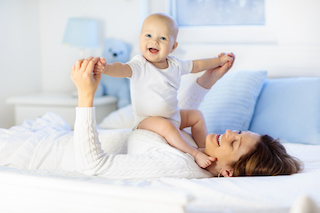 Why would it matter if infants displayed empathy?
Why would it matter if infants displayed empathy?
“Empathy is defined as the ability to understand the emotion of others, and share in those emotions, while maintaining a self-other distinction,” Florina Uzefovsky, of the Ben-Gurion University of the Negev, told us. “As can be understood from the definition, empathy is basic and central in all social communication. This ability allows us to interact with others, to better understand their motives and actions, and to engage in meaningful social relationships.”
To test whether infants have empathy, Uzefovsky used an experiment that showed infants videos of two characters, one being bullied and expressing distress and the other having a positive social encounter and expressing neutral-positive emotion. The experiments were part of her recent study published in the British Journal of Psychology.
“After observing the videos several times, we presented the same characters to the infants and asked them to choose one which they prefer,” Uzefovsky told us. “We coded preference based on the character that the infants chose by grabbing or touching it.”
In the second experiment (with an independent group of infants) researchers showed the same character expressing the emotion alone, without any preceding context for the emotional expression. Again, infants were able to choose one of the characters.
“The implications of this study are far reaching,” Uzefovsky told us. “It teaches us about infants’ abilities, how they judge the social world, and even perhaps about the early manifestations of morality.”
Uzefovsky says empathy to distress can lead to prosocial behavior, which is also basic in human society and social living. As such, empathy is of paramount interest and importance. Although there is a lot of research on empathy, there is still a lot that is unknown, and that is especially true for the early development of empathy.
“Since there’s been hardly any research into empathy during the first year of life, we do not understand early empathy and how it develops,” Uzefovsky told us. “Therefore, we wanted to unravel the different aspects of empathic responses during the first year of life. We designed the task to be able to deconstruct the conditions for empathic responding so as to better understand how infants relate to the social world.”
In the current study, researchers aimed to test a task of empathic preference which will allow them to better understand if babies show empathy. And later on, by manipulating parts of the task, to better understand what the necessary conditions are for this preference to manifest.
“We were particularly interested whether infants respond to distress per se, or whether they respond to the context in which it occurs as well,” Uzefovsky told us. “We know that older children and adults judge the context of the emotional presentations when deciding whether to show empathy or not; they dislike cry-babies for example, and we wanted to see whether the same holds for young infants. The task that was developed for this study is the first to allow such a distinction to be made, empirically, with such a young age group.”
Based on previous research, Uzefovsky said she expected to see empathic preference in the first study, where both context and emotional display were clear. However, she was surprised as to how strong the response was. Over 80 per cent of the infants chose the bullied victim.
“We thought that we might see higher variation in infants’ response,” Uzefovsky told us. “In the second experiment, where only an emotional display was evident, we were less sure as to what the response would be. We know that people tend to want to be near happy others, so if there is no context for the distress it was plausible that infants would choose the happy character, but if infants respond to the emotional display, irrespective of context, they would continue choosing the sad character.”
The study shows that infants in fact make complex judgments, Uzefovsky says, not only those needed to understand the emotional display, but also those needed to understand the context in which the emotional display occurs.
“The findings show that infants’ social perception is complex in that they understand social situation and express empathic preference to those who have been harmed and show distress, but not to cry-babies, showing distress with no harm,” Uzefovsky told us. “Moving forward, we aim to take advantage of this task and manipulate it in different ways to better understand under which conditions infants show empathic preference.”
Patricia Tomasi is a mom, maternal mental health advocate, journalist, and speaker. She writes regularly for the Huffington Post Canada, focusing primarily on maternal mental health after suffering from severe postpartum anxiety twice. You can find her Huffington Post biography here. Patricia is also a Patient Expert Advisor for the North American-based, Maternal Mental Health Research Collective and is the founder of the online peer support group - Facebook Postpartum Depression & Anxiety Support Group - with over 1500 members worldwide. Blog: www.patriciatomasiblog.wordpress.com
Email: tomasi.patricia@gmail.com